
News
Behind the Headlines
Two-Cents Worth
Video of the Week
News Blurbs
Articles
Testimony
Bible Questions
Internet Articles (2015)
Internet Articles (2014)
Internet
Articles (2013)
Internet Articles (2012)
Internet Articles (2011)
Internet Articles (2010)
Internet Articles
(2009)
Internet Articles (2008)
Internet Articles (2007)
Internet Articles (2006)
Internet Articles (2005)
Internet Articles (2004)
Internet Articles (2003)
Internet Articles (2002)
Internet Articles (2001)
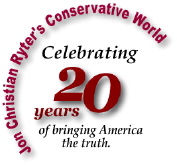
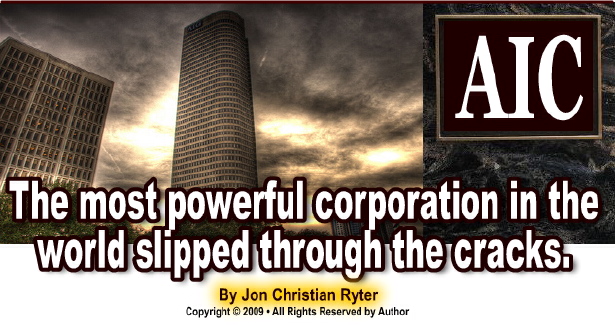
 ou
know about the American International Corporation today only
because of the greed of the executives in one of its subsidiaries, American
International Group [AIG}. If we use a search engine, we know AIG
as a global insurance company founded in Shanghai, China in 1919. But
when we walk past the American International Building at 70 Pine
Street in New York where AIG is headquartered, we think of it as the
AIG Building. It's not. It's the AIC Building. There is a difference.
ou
know about the American International Corporation today only
because of the greed of the executives in one of its subsidiaries, American
International Group [AIG}. If we use a search engine, we know AIG
as a global insurance company founded in Shanghai, China in 1919. But
when we walk past the American International Building at 70 Pine
Street in New York where AIG is headquartered, we think of it as the
AIG Building. It's not. It's the AIC Building. There is a difference.
We know that
AIG, the insurance giant which has pretty much dominated the headlines
for abusing the use of $170 billion of TARP money received from the
pockets of working class taxpayers, is a behemoth global insurance carrier—and
one of the most powerful corporations in the world. But, if you ask
anyone on the street to name the world's largest insurance company no
one, until now, would have suggested it might be AIG. 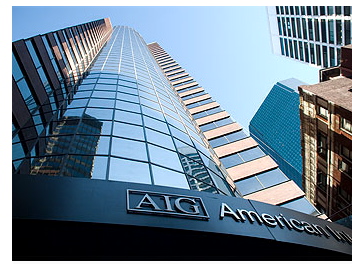 They
will answer either MetLife (Metropolitan Insurance Co.),
which has $3.3 trillion if insurance in force, or Prudential which has $2 trillion. Yet, AIG is larger than the top five "household
name" life insurance companies put together. It has 375 million
policyholders and over $19 trillion of insurance in force. Why in the
world did AIG need a bailout?
They
will answer either MetLife (Metropolitan Insurance Co.),
which has $3.3 trillion if insurance in force, or Prudential which has $2 trillion. Yet, AIG is larger than the top five "household
name" life insurance companies put together. It has 375 million
policyholders and over $19 trillion of insurance in force. Why in the
world did AIG need a bailout?
The AIG subsidiary that caused most of the unsecured losses for the company was AIG Financial Products Corp, (the derivatives division) in London, England. AIG said its "bad bet" losses (totaling $40.5 billion last year) were the result of using what are known as "credit default swaps" that promises investors payments in mortgage bonds in the event of a default. The "credit default swaps" were used to help financial institutions insure their subprime securities holdings. As the losses mounted throughout 2008 over the subprime meltdown in 2007, AIG depleted its capital reserves—not by covering its debt owed to the financial organizations who expected payment in mortgage bonds from a company whose parent's word has been its bond since 1910, but in an AIG stock buyback as its stock plummeted in value.
When the US taxpayers, who oppose bailing out the rich, learned that AIG planned to use $450 million of the TARP money to pay promised bonuses to executives (but only after it had already shelled out $165 million of the original $170 million to executives in its derivatives department in London) the proverbial brown stuff hit the fan in Washington, DC. (It should be noted that AIG FP also has an unobtrusive office at 50 Danbury Road in Wilton, Connecticut. The building is the US headquarters for AIG FP. AIG FP in Wilton also handles derivative contracts, but it's unknown if any, or how many, US employees have, or will, received any of these extravagant bonuses.
The Democrats—the 21st century equivalent to the 1920s Keystone Kops, who proudly call the spending bills they single-handedly rammed through Congress without a single GOP vote a "bipartisan effort" (between liberal and moderate Democrats) are now feeling the type of backlash that causes arrogant politicians to lose their jobs and control of Congress to shift from one party to the other. When the politicians stick their hands too deeply into the pockets of the taxpayers, the taxpayers tend to remember the theft the next time they step into the voting booth—particularly when the great, great grandchildren of those taxpayers will still be paying the bill. The rich fat cats who profited from the financial meltdown of 2008 (reminiscent of the Bank Panic of 1906), will also still be recalling the Bailout of 2009, but they will remember those days as the turning point when the working class was returned to their medieval roles as the chattel of the overlords of banking and industry.
When Merrill Lynch paid extravagant bonuses totaling $121 million out of its TARP funds to key executives, the public became outraged. New York Attorney General Andrew Cuomo quickly issued subpoenas to force Merrill Lynch to provide the names of the executives who received bonuses.
When the Merrill Lynch greedfest was repeated by AIG Financial Products, it prompted some Democratic Congressmen and Senators to write into the second go-round of bailouts, the American Recovery and Reinvestment Act of 2009 a provision that would restrict bonuses, or heavily tax them. However, when the House and Senate versions of the Recovery and Reinvestment Act were being reconciled in Joint Conference the language was altered and all restrictions were erased. Under both House and Senate rules, when bills are reconciled in joint conference, the leadership of both parties meet and iron out the differences. No Republican has been allowed to attend any joint conference thus far in the 111th Congress. The bills were reconciled by Senate Majority Leader Harry Reid, Speaker Nancy Pelosi and White House Chief of Staff Rahm Emanuel.
On Thursday, Mar. 19, the House met and, before the sun set, it had enacted HR 1586 which imposed a 90% surtax on TARP recipients. Reid tried to ram the Senate version through that chamber on a voice vote on Friday but he was stopped by Sen. Jon Kyl [R-AZ] who successfully argued that "...I don't believe that Congress should rush to pass yet another piece of hastily crafted legislation in this very toxic atmosphere, at least without understanding the facts and the potential unintended consequences. Frankly, I think that's how we got into the current mess." The new income tax imposes a surcharge on family incomes over $250 thousand who work for companies that received bailout packages of at least $5 billion.
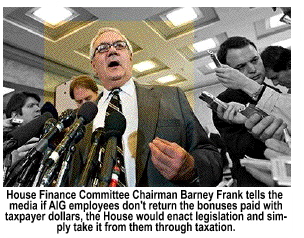 You
need to read no farther than the heading of the legislation, "A
Bill to impose an additional tax on bonuses received from certain TARP
recipients..." to know the legislation was unconstitutional.
The Constitution of the United States says no bills of attainder or
ex post facto laws can be passed. A bill of attainder is a law that
singles out a person or particular group of people for punishment. An
ex post facto law is one that punishes someone after-the-fact for conduct
that was not illegal when it was committed.
You
need to read no farther than the heading of the legislation, "A
Bill to impose an additional tax on bonuses received from certain TARP
recipients..." to know the legislation was unconstitutional.
The Constitution of the United States says no bills of attainder or
ex post facto laws can be passed. A bill of attainder is a law that
singles out a person or particular group of people for punishment. An
ex post facto law is one that punishes someone after-the-fact for conduct
that was not illegal when it was committed.
Even though the Democrats know the TARP Bonus Taxation Bill proposed by House Ways & Means Committee Chairman Charlie Rangel [D-NY] and 43 cosponsors violates the Constitution on two points, after George Washington University Law Professor Jonathan Turley said targeting AIG employees invited a court challenge, the Democratic leadership challenged anyone who wanted to, to take them to court. It really doesn't matter to the far left if AIG executives get to keep their bonuses because, ultimately, the far left will be able to keep their 90% tax on incomes over $250 thousand.
But here's the rub. The American people have been so focused on the AIG bonus money they ignored a closer look at a major US corporation that has flown completely off the media radar screen for just under 100 years. American International Corporation [AIC], the parent, will celebrate its centennial anniversary next year.
![]()
For a century the American International Corporation succeeded in remaining invisible
because its founders thrived on absolute secrecy. And, those founders—were?
AIC was incorporated in 1910. While Charles Stone's name appears
as the historic founding head of AIC, the company was the brainchild
of John D. Rockefeller, Sr., Andrew Mellon, J.P. Morgan,
and Andrew Carnegie. An assortment of American industrialists,
bankers and merchant princes joined the AIC parade over the next couple
of years because they were convinced that, with the financial clout
of the world's wealthiest men behind it, the new 800-lb economic gorilla
on the horizon was going to be Russia. They all wanted a piece of the
action in a new economy devoid of thousands of government restrictions
that hamstring business.
Rockefeller's interest in Russia stemmed from the discovery of oil in Baku near the Caspian Sea in Azerbaijan. The oil field was the largest known oil strike in the world. It was controlled entirely by the Swedish munitions manufacturers Alfred and Robert Nobel and Tzar Nicholas II's banker, Baron Alphonse Rothschild. By 1884 Rothschild and Nobel were pumping as much oil from the Baku Oil Fields as Rockefeller was from all of his holdings in the United States. Rockefeller was determined to do in Russia what he had succeeded in doing in the United States in two decades—corner the refining and distribution of oil. By 1870 Standard Oil controlled 85% of the refining and distribution of oil in the entire world. By 1880, he lost most of his distribution rights in Europe to Rothschild.
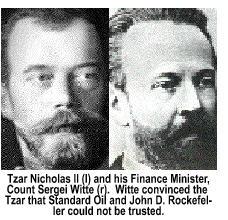 Two
things stood in his way of challenging Rothschild's Mazout and Bnito oil refining and distribution companies. One was the
Tzar. The other was Count Sergei Witte, the Russian Finance Minister. Witte knew of Rockefeller's reputation for buying politicians
and destroying competition, and convinced the Tzar to bar Standard
Oil and Rockefeller from coming into Russia. In 1905 Alphonse
Rothschild died. His younger brother, Edmond, became the
head of the Rothschild empire. He offered Mazout and Bnito to Nobel, who could not afford the asking price. When Rockefeller offered to join forces with Nobel, the Tzar rescinded the offer.
Deutsche Bank was then offered the Rothschild oil fields.
Two
things stood in his way of challenging Rothschild's Mazout and Bnito oil refining and distribution companies. One was the
Tzar. The other was Count Sergei Witte, the Russian Finance Minister. Witte knew of Rockefeller's reputation for buying politicians
and destroying competition, and convinced the Tzar to bar Standard
Oil and Rockefeller from coming into Russia. In 1905 Alphonse
Rothschild died. His younger brother, Edmond, became the
head of the Rothschild empire. He offered Mazout and Bnito to Nobel, who could not afford the asking price. When Rockefeller offered to join forces with Nobel, the Tzar rescinded the offer.
Deutsche Bank was then offered the Rothschild oil fields. 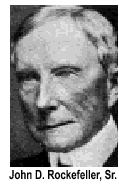 When Rockefeller's shadow became visible in the Deutchebank deal,
the Rothschilds were forced by the anti-Jewish conservatives
in the Russian government to sell to Royal Dutch Shell or see
their assets seized by the Russian government.
When Rockefeller's shadow became visible in the Deutchebank deal,
the Rothschilds were forced by the anti-Jewish conservatives
in the Russian government to sell to Royal Dutch Shell or see
their assets seized by the Russian government.
Rockefeller knew the only way he was going to get into Russia was to depose Tzar Nicholas II. At the moment, Rockefeller, Morgan, Mellon and his banker friends were already working hard to create the legislation needed to change the nature of the US republic by eliminating the States from the equation of power in order to create a central bank owned by them, and to legislate a national income tax to repay what the United States would soon owe to that privately-owned central bank.. Taking over a foreign country, on the other hand, required a little more effort than bribing a few Congressmen and Senators to legislate a new central bank and manipulate a Constitution by bribing politicians at both State and federal levels to ratify two constitutional amendments to make the government work better for them.
After several meetings in New York between the capitalists and Bolshevik Leon Trotsky between 1907 and 1910, Rockefeller, bankers Mellon and Morgan and steel magnate Andrew Carnegie, together with several of America's leading barons of business and merchant princes, pooled their resources, put up $50 million, and formed the American International Corporation. AIC, the cartel announced, was created to stimulate world trade. In reality, AIC was created to fund the overthrow of Tzar Nicholas II by the Bolsheviks. In a deal struck with Trotsky and revolutionist Vladimir Ulyanov, whom the world knew as Lenin, in exchange for financing the Bolshevik Revolution, the capitalists would be allowed to carve up the economy of what was soon to become the Soviet Union—the most terrifying anti-capitalist nation in the world. What that means in plainspeak is that Lenin and Trotsky doublecrossed the richest men in the world. Had the barons of business and merchant princes of America not tried to create their own version of the United States in Central Europe, the 1917 Bolshevik Revolution would have been a fizzle-farce just like the abortive January 22, 1905 Revolution that began and ended in front of the Tzar's Winter Palace on Bloody Sunday. Tzarist guards shot and killed over a hundred peasant protesters. Instead, the well-financed Bolsheviks won and deposed the Romanov dynasty.
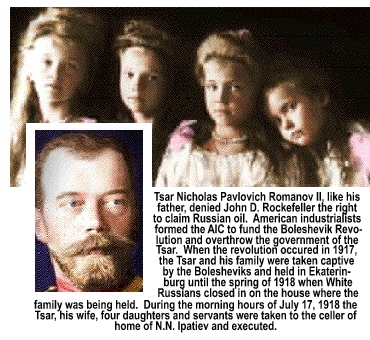 Tzar
Nicholas Pavlovich Romanov and his family were taken captive on
Feb., 17, 1917 when the Bolsheviks captured the Winter Palace in St.
Petersburg (which they renamed Petrograd). The Tzar and his family were
held captive until the early morning hours of July 17, 1918 and, with
the White Russians closing in on the villa where they were held, the Bolsheviks took the Tzar, his wife, children, and their servants
to the fruit cellar and executed them.
Tzar
Nicholas Pavlovich Romanov and his family were taken captive on
Feb., 17, 1917 when the Bolsheviks captured the Winter Palace in St.
Petersburg (which they renamed Petrograd). The Tzar and his family were
held captive until the early morning hours of July 17, 1918 and, with
the White Russians closing in on the villa where they were held, the Bolsheviks took the Tzar, his wife, children, and their servants
to the fruit cellar and executed them.
When Lenin and the Red Army doublecrossed AIC, there were several small anti-Bolshevik separatist movements brewing throughout Russia. Those aligning to fight the Bolsheviks were landowners, middle class citizens, pro-monarchists, and other reactionaries and non-Bolshevik communists. The agents of AIC recruited one of these groups, known as the White Movement (hence, the White Army) to defeat the Bolsheviks. The White Army was headed by Generals Anton Ivanovich Denkin and N.B. Yudenich and Admiral Alexander Vasilyevich Kolchak. When the Bolshevik Revolution took place, the Whites controlled most of the country even though Lenin controlled the urban centers and the government.. AIC funded the Whites, whose ranks included most of the Tzarist officer corps—and most of the Tzar's military equipment. The White Army was actually better equipped than the Red Army. While history records the Russian Civil War as happening between 1918 and 1921, major fighting between the Reds and Whites did not stop until Oct. 25, 1922, with Gen. Anatoly Pepelyayev surrendering the last enclave of White forces on June 13, 1923.
When Lenin reneged on his deal with the American International Corporation, the money barons at AIC used their political clout to keep the American Expeditionary Forces fighting in Europe until April, 1920—16 months after World War I officially ended. On July 26, 1918 British forces under Gen. Lionel Dunsterville captured the Baku oil fields from the Ottomans. American Expeditionary Forces hurried to their defense when a major Ottoman counteroffensive took place between Aug. 26 and Sept. 14. The Allies held the oil fields for two years.
At the Paris Peace Conference in in November, 1919, the Soviets, who were blocked from participating because they were fighting a civil war, complained that Allied forces had invaded their country. At the time, the Brits were actively soliciting Russia's neighbors to attack the Bolsheviks. The League of Nations voted that no new Allied troops could be introduced into Russia and that all Allied intervention had to stop. Congress, which professed not to understand why US forces were engaged in Russia, demanded that the Wilson Administration bring the boys home. In early April, 1920, the last US troops left the Baku oil fields. On April 28, 1920, the 11th Red Army overwhelmed the weakened British forces that were still holding Baku, and took the oil fields back, ending World War I, and creating the reason for the Iron Curtain which would divide East and West for 68 years.
Who, or what, precisely, is American International Corporation? AIC is one of the two largest corporations ever formed. The other is Standard Oil which, which was broken apart by US District Court Judge Kenesaw Mountain Landis on August 3, 1907. At 4 p.m. on May 15, 1911, the US Supreme Court upheld the Landis judgment, and what was one behemoth oil giant became seven behemoth oil giants—with the Rockefeller family as the primary shareholders in all of them. The government would ultimately learn from its Standard Oil mistake because when the Reagan-era Supreme Court broke up Ma Bell, AT&T was forced to sell-off the breakaway companies.
When Rockefeller, Mellon, Morgan and Carnegie masterminded the birth of AIC, they built the corporation in what can be construed as "Standard Oil secrecy layers" that defy scrutiny. Most of the executives brought into the fold were trusted associates from each partner's own commercial ventures. Media leakage has never been a problem. The principles are so powerful that careers are made or lost by their spoken word. On top of that, their executives are compensated so well there is never a question about loyalty.
From Rockefeller's National City Bank came Frank Vanderlip, one of the Jekyll Island Seven who would not only help write the Federal Reserve Act legislation, he would also help leverage State politicians to enact the 16th and 17th Amendments by promising them fame and fortune—or failure. Vanderlip was on the board of AIC. So were notables who served at various points of time throughout AIC's century-old life, like Thomas Vail, CEO of AT&T, Percy Rockefeller (one of Senior's brothers), James A. Stillman (a Rockefeller in-law), Pierre DuPont, and George H. Walker, maternal grandfather of George H.W. Bush.
In the war years Robert S. Lovett joined the board. He would become a key advisor to President John F. Kennedy. He was one of the authors of State Department Publication 7277 on global disarmament. Lovett advocated breaching the 2nd Amendment and disarming the American people as the first step in creating global government.
Other founding directors included manufacturer Cyrus McCormick; railroad executive James J. Hill; Edwin S. Webster (Stone's partner); investment banker Otto Kahn, meat-packer Ogden Armour; Assistant Secretary of the Treasury for Taft, Beekman Winthrop; Henry Smith Pritchett, president of the Carnegie Corporation; and Joseph P. Grace, then a Standard Oil chemist. He developed petrochemical products from crude oil. Also, banker Charles H. Sabin; W.E. Corey, head of US Steel; James Cash Penney, founder of J.C. Penney; and Charles A. Coffin, who replaced Thomas Edison as CEO of General Electric.
![]()
The lives of the world's wealthiest families—the Money Mafia—are secrets shrouded by such complex layers of anonymity that the world knows nothing about them while believing they know everything. The Money Mafia encourages the fables—providing they downplay rather than magnify their wealth. In the opening days of the 20th century when JP Morgan took a young reporter from the New York American and Leslie's Weekly under his wing, he did so because Morgan wanted a conduit through which he could control the news. The reporter was Bertie Charles Forbes whom, with the help of Morgan, founded Forbes magazine.
In 1918, Forbes published his first list of the 30 richest America. Heading the list were the invisible rich whose wealth is never supposed to be mentioned by the media. Among them, alphabetically, were J. Ogden Armour, Vincent Astor, Andrew Carnegie, Pierre DuPont, Henry Clay Frick, Daniel Guggenheim, Cyrus McCormick, John Pierpont Morgan, John D. Rockefeller, Sr., Russell Sage, Jacob Schiff, Charles M. Schwab, and William Vanderbit. Since all but a few of these names own shares of the Federal Reserve, it is unlikely that any of them became "less rich" over time. The business holdings of these men included oil, coal, railroads, steel, gold and silver mining, and investment banking. Rockefeller headed the Forbes list. His wealth in 1918 was conservatively estimated at $1.2 billion by Forbes—in an age when a bank president who earned $5,000.00 per year and was considered to be an extremely wealthy man.
These were the kingmakers of the New World Order at a time when the Old World Order—the royalty of Europe, and the vast landowners of Europe—began to lose their grip on global power as the 20th century broke on the horizon. The lofty and often utopian objectives of the princes of industry and barons of banking and business were at odds with the goals of the monarchs of Europe who had ruled vast kingdoms and municipal fiefdoms that have existed since medieval days. A New World Order was formed in the ashes of World War I, with the new wealth of the New World overwhelming the old wealth of Europe. The money barons wanted a world without borders with a common currency with which to trade anywhere in the world. A global economy with a global government .
Rockefeller demanded that Forbes pull his magazine off the store shelves in 1918—and reprint it. Forbes did. From that day until now, none of the names of the wealthiest families in the world appear on any of the "wealthiest family" lists. Only the poor rich appear. The first layer of secrecy was in place.
The second
layer of secrecy is confusion. Keep them guessing. When everyone is
telling a different story about the histories of the accumulation of
the wealth of the rich, no version is believable. Not even the measurable
wealth of those associated with those who possess unfathomable wealth. American International Group [AIG] is a subsidiary of AIC. 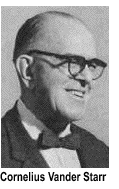 Internet
searches suggest that AIG was created in 1919 by a 27-year old named Cornelius Vander Starr, a recently discharged US Army buck private
from Fort Bragg, California (a military installation from 1859-64).
However, the facts don't support the legend.
Internet
searches suggest that AIG was created in 1919 by a 27-year old named Cornelius Vander Starr, a recently discharged US Army buck private
from Fort Bragg, California (a military installation from 1859-64).
However, the facts don't support the legend.
Sadly, on the Internet, when urban legends are repeated often enough they obfuscate the truth. Fiction becomes reality. Legend would have us believe a 27-year old, with no advanced education and no money, who served 8 months in the army at the end of WWI—and who never fought in the war and never took officer's training—was discharged as a 2nd Lieutenant after 8 months of service. Legend would have us believed he joined an insurance brokerage firm, Shean & Deasy and virtually overnight became its manager, yet quit his dream job after only a few months to become a mail clerk with the Pacific Mail Steamship Co. Starr, the legend goes, wanted to see the world—which was why he purportedly joined the Army. (Note: In 1914 the Pacific Mail Steamship Co., was purchased by AIC to get the US mail contracts for Asia, and to serve as a toehold in Asia for AIC. AIC in 1914 had already embarked on the path to creating a global economy. The first attempt by the money mafia to create world government would come in the Treaty of Versailles in 1920. The United States never signed it.)
C.V. Starr, who was born on Oct. 15, 1892, graduated from Fort Bragg High School in 1909. He began selling life insurance for the James Nelson Realty Co. in Fort Bragg around 1913. In 1914 he moved to San Francisco to sell auto insurance for the Pacific Coast Casualty Co. In 1917 he went to work for an insurance brokerage firm, Shean & Deasy, leaving them to join the army. Logic suggests he came out of the service 8 months later when the Armistice was signed as a buck private. As a soldier, he went no where and did nothing at a time when soldiers might spend one whole hitch waiting for one stripe. Some of Starr's biographers claim he came out of the army as a sergeant, others claim he made lieutenant. Neither makes sense and sound like someone remodeling Starr's past to give him a biography worthy of a wealthy man's latter-year stature.
Starr and Frank Raven formed American Asiatic Underwriters—an insurance agency selling policies, not issuing them. Raven had been selling insurance in China since 1904, and had been very successful. He amassed several million dollars, enough to begin underwriting policies. That history's probably correct. At some point, Starr and Raven formulated plans to create an insurance company that would actually insure the policyholders. That, too, is correct. But, that company was not AIG. It was AAU.
Starr returned to the United States and convinced several American insurers—in particular Globe Life, Rutgers and National Union—to act as a re-insurer, covering AAU's risk. There may have been a stipulation that forced AAU to open sales offices in the United States since that happened. But now, at age 29, Starr was on his way. But not with AIG. The new company was American International Underwriters [AIU].
(My research revealed an American International Group IPO to purchase AIU. I could not determine the date of the IPO.) Starr and his partner managed to build a very lucrative, very successful insurance company with relatively low capital in about two decades. They were so successful that AIU was under contract to manage all of AIG's overseas property-casualty business. Using guesswork alone it's likely the IPO was exercised sometime between 1947 when Mao overran China and 1950 when Starr created a new entity, CV Starr & Company. Or, at the latest, in 1955 when he formed the CV Starr Foundation whose wealth was comprised largely of AIG stock that is now worth about $3.5 billion. None of the various websites contain the history of AAU, AIU, AIG or AIC. It's almost like all of them encourage legend building.
The third layer of secrecy like the fourth, fifth, sixth and seventh layers of secrecy are, well...heavily shrouded secrecy. Piled on, layer after layer, to make it impossible for anyone to learn the truth about the wealth of the wealthiest families in the world. That wealth is so vast that it simply can't be measured in terms of dollars and cents.
The estimated "wealth" of the truly wealthy is calculated not on the total gross worth of the cash, investments and other wealth of that individual or family, but on the interest received on those those investments and holdings that are paid directly to that individual or family quarterly or annually and reported to the IRS as income. Roughly 99% of the wealth of these individuals is sheltered in tax-free trusts and foundations.
When you examine the maze that obfuscates a man who was not part of the world's elite but merely brushed the shroud that shields them, you can begin to understand how, when you ask 20 different people who the six richest men in the world might be, you will get at least a dozen answers with few of them actually getting it right. That explains how one of the most powerful corporations in the world can simply slip through the cracks.

Copyright © 2009 Jon Christian Ryter.
All rights reserved.


